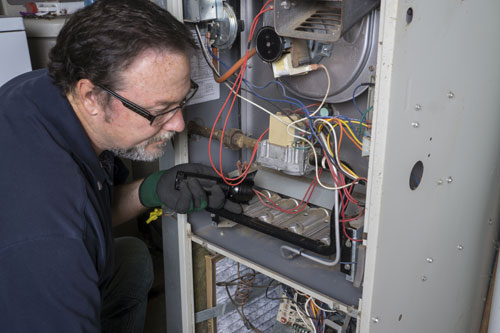What Does A Furnace Inspector Look At?

Routine heating maintenance and professional inspections are keys to keeping your furnace in top shape through the long Massachusetts winter. But what goes into a good furnace inspection, and what problems might it uncover? Let’s take a closer look.
Heating System Inspection Areas
A complete, professional furnace and forced-air tune-up by a NATE-certified inspector will include a detailed look at each of the following components:
- Heat exchanger – If your heat exchanger is performing poorly, your system will generate less heat and perform less efficiently than it should, resulting in higher bills. Heat exchangers can get dirty, or, in a worst-case scenario, can crack; the latter situation can can be quite dangerous, since it can cause a build-up of carbon monoxide inside your home (a big reason why you should have your furnace maintained every year).
- Furnace interior – Soot can accumulate inside your oil-fired furnace, which can rob it of efficiency. If your technician finds soot build-up, he will conduct a nozzle inspection; if the nozzles are dirty, he will replace them.
- Air filters – Clogged air filters are another potential contributor to poor efficiency. Over time, air filter blockage can even lead to system failure. During your inspection, a technician will see if your filters should be cleaned or replaced.
- Thermostat – A technician will test your thermostat to make sure it is operating correctly.
- Flue / emission system – Your technician will also collect flue gas samples to test your system’s efficiency, along with the oxygen, smoke content, and temperature of its emissions.
- Burners, switches, blower motors, and fan belts – A heating inspection should also include a cleaning of all burners, switches, and blower motors, and a check of fan belts for any signs of cracking or breakage.
Common Issues Uncovered During An Inspection
While each inspection will uncover different issues, there are some problems that occur more often than others. Some of the more common inspection issues include:
- Clogged air filters
- Dirty nozzles
- Excessive wear and tear
- Electrical ignition / pilot control problems
- Frequent cycling
- A faulty thermostat
- A noisy furnace
- A blower that will not shut off
- Insufficient or no heat generated
Commonly Replaced Furnace Parts
Some parts in your heating system are more prone to wear and tear than others, and replacing them will help your furnace last longer and run more efficiently. Some of the more commonly replaced parts in your heating system include:
- Air filters
- Nozzles
- Thermocouple
- Limit switch
- Belts
- Ductwork (may need to be redesigned)
- Coils
- Exchangers
- Compressors
- Drain Lines
- Valves
- Fan Motors
- Fuses
- Ventilation System
As you can see, there’s a lot going on in your forced-air heating system, which is why you should always have your equipment serviced by a qualified technician. At FSi, our experienced pros will get the job done quickly and correctly so you get the performance you need month after month, year after year.
There is still time to have your furnace checked and maintained before the cold weather arrives in western MA! Contact us today to sign up for a high value FSi Service Plan for your oil- or gas-fired furnace, which includes a tune-up, discounted repairs, priority emergency service 24/7/365, and more!



